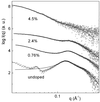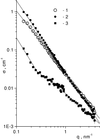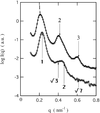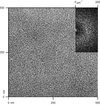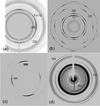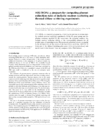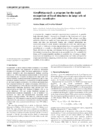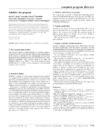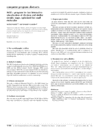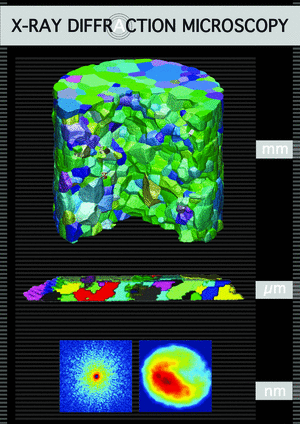issue contents
August 2003 issue

Cover illustration: Protein crystals in a 2 µl gelled microbatch drop dispensed automatically under oil. Courtesy of A. Moreno, E. Saridakis & N. E. Chayen [J. Appl. Cryst. (2002), 35, 140-142].
research papers
Hybrid organic–inorganic nanocomposites doped with FeII and FeIII ions and exhibiting interesting magnetic properties have been obtained by the sol–gel process. The different magnetic features between FeII- and FeIII-doped samples are consistent with the structural differences revealed by small-angle X-ray scattering.
The poly(N-vinylcaprolactam)–D2O system has been investigated by small-angle neutron scattering (SANS) at T = 296–316 K to identify the structural features of the coil–globule transformation.
Association behaviour of an amphiphilic X-shaped octablock poly(ethylene oxide)/poly(propylene oxide) copolymer with hydrophobic (PPO) terminal blocks in aqueous solutions was studied using small-angle neutron scattering and differential scanning calorimetry.
Small-angle X-ray scattering experimental observation of the transformation of cubic symmetry from face-centred cubic (f.c.c.) to body-centred cubic (b.c.c.) for spherical microdomains upon uniaxial stretching of poly(1,3-cyclohexadiene)-block-poly(ethylene-co-but-1-ene)-block-poly(1,3-cyclohexadiene) triblock copolymer is reported.
An as-cast specimen of a polystyrene-block-poly(ethylene-alt-butylene)-block-polystyrene (SEBS) triblock copolymer with lamellar microdomains underwent the temperature jump from 363 to 403 K and the morphological transition from lamellae to cylinders was observed as a function of time by the TR-SAXS technique. Singular value decomposition (SVD) analysis strongly suggested the existence of a third basis component of the X-ray scattering profiles, thus supporting that there is an intermediate state during the transition from lamellae to cylinders.
The nanostructure and thermal behaviour of novel melt-processable molecular composites were examined by real-time synchrotron small-angle X-ray scattering and wide-angle X-ray diffraction methods, and differential scanning calorimetry. The synthesized oligoester, with low melting temperature (391 K), exhibits the ability to form a thermotropic mesophase.
Simultaneous time-resolved small-angle and wide-angle X-ray scattering techniques were used to probe the early stages of melt crystallization in low-density polyethylene. Both the scattering invariant and the degree of crystallinity were found to evolve by Avrami-type growth law.
Systematic small-angle neutron scattering investigations of different polymer–paraffin systems have shown that PEB-n copolymers are selective in their paraffin-modification capacity, depending on the crystalline degree which is tuned by the number `n' of ethyl side branches/100 backbone C atoms. Two mechanisms of polymer–paraffin interaction have been identified: on the one hand, co-crystallization of the paraffin and copolymer within thin platelets occurs as a consequence of a good fit between the self-assembling properties of the investigated polymer/paraffin pairs (PEB-7.5/C36 and PEB-11/C24); on the other hand, primordial polymer aggregates act as a template for a subsequent paraffin crystallization when the polymer has a higher self-assembling point (PEB-7.5/C24) than the paraffin.
Solutions of a rigid polyelectrolyte molecule, sulfo-poly(phenyleneterephthalamide) (SPTTA), in deuterated water have been investigated using small-angle neutron scattering.
The microstructure of defective crystalline domains embedded in heavily amorphized zircon is studied as a function of pressure, up to 7 GPa. Results are used to gain insight into the topology of amorphous zircon.
An experimental method to determine simultaneously the compaction and the total specific area between an inorganic oxide network and a material of low electronic density is presented. This method is applicable when both the Porod limit and the invariant can be extracted from the small-angle X-ray scattering pattern on an absolute scale.
The image analysis of TEM micrographs shows a quantitative correlation with SAXS measurements of the characteristic distances in semi-crystalline polymers.
Of the three orthorhombic ZrO2 structures, with space groups Pbcm, Pbc21 and Pbca, it is shown that the crystal structure of orthorhombic ZrO2, formed in magnesia partially stabilized zirconia as a result of polishing, can only have space group Pbcm.
Precise high-temperature synchrotron measurements of the cell parameters of decagonal Al71.2Co12.8Ni16 have enabled the investigation of the anisotropic thermal expansion behaviour in the range of the type I ↔ S1 phase transition.
Practical aspects of texture measurement and data processing procedures to enable the application of orientation distribution function reconstruction methods in synchrotron experiments are described. Previous applications are reviewed and some opportunities for synchrotron texture analysis are highlighted based on case studies on different materials.
The experimental geometry obtained from single-crystal X-ray diffraction for a number of binuclear S-bridged manganese complexes is compared with the results of theoretical calculations. The mean square deviation for bond lengths (angles) was found to be between 0.046 Å (1.1°) and 0.004 Å (0.7°) depending on the theoretical model used.
The effects of the choice of oxygen scattering curves with different ionization levels and of the number of spherical harmonics terms used to correct for preferred orientation are discussed in the case of the Rietveld refinement of MgAl2O4 spinel.
Embedded grain boundaries in a polycrystal are mapped non-destructively by hard X-rays and an iterative algebraic algorithm.
The size distribution and aggregation of particles in ferrofluids were quantitatively determined by means of small-angle scattering.
The lattice parameters of α-Al2O3 have been measured in a temperature range from 4.5 to 250 K with a relative accuracy of better than 6 × 10−6.
short communications
Download citation


Download citation


Structural analysis of anion-rich C-type Gd2O3 was carried by the Rietveld refinement of the powder X-ray diffraction data for compositions Gd0.8Ce0.2O1.60 and Gd0.6Ce0.4O1.70. The details of these two compositions are explained and compared with both the CeO2 structure and the Gd2O3 structure, i.e. the end member.
computer programs
NEUTRON is a program for the determination of phonon extinction rules in inelastic neutron scattering experiments.
A program that computes molecular superpositions is presented. A possible large molecule (target) is scanned for the occurrence of a given molecular motif (model), within tolerances, both being represented by all non-hydrogen atoms.
PSILAM makes possible the calculation and graphical representation of multiple-diffraction ψ−λ peak location plots and can be applied to X-rays as well as to neutrons.
computer program abstracts
BEAM-ish 2.0 is a graphical user interface that manages the processing of multiple super-fine φ-sliced diffraction images for crystal quality analysis, seamlessly links together several programs, provides a central storage directory for files generated at all stages of the analysis, and allows the user to visualize and check the results.
A new direct-methods program, SIR2002, which has been designed to solve both small and large crystal structures, is described.
MCE software, which provides fast electron-density visualization for small-molecule crystallography, is described .


 journal menu
journal menu








